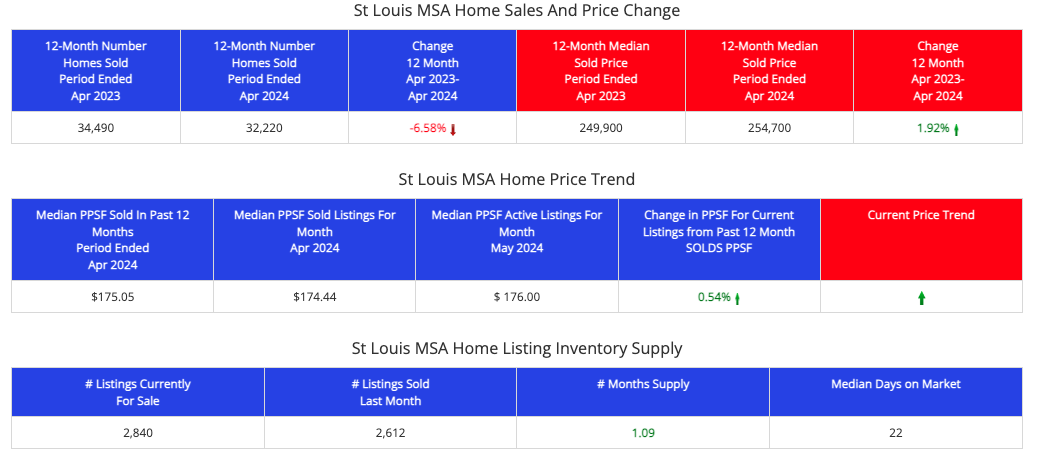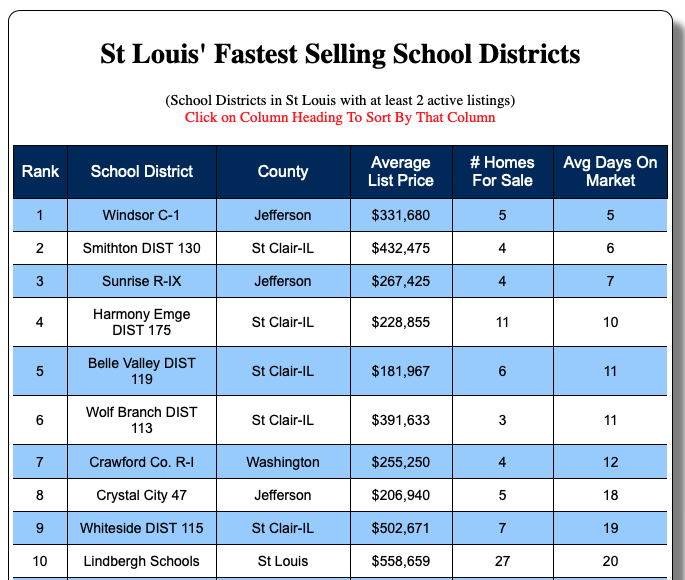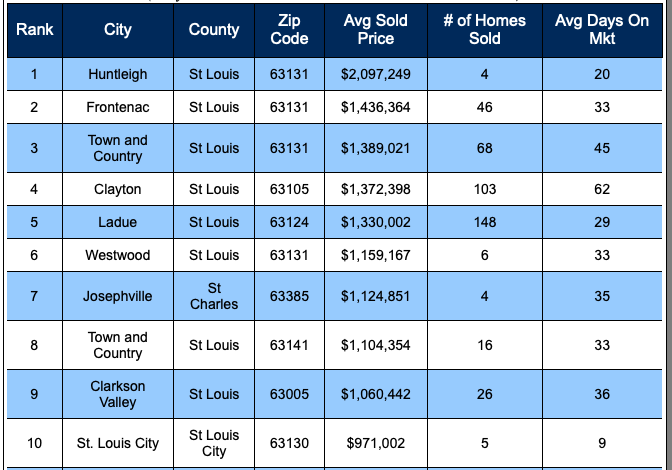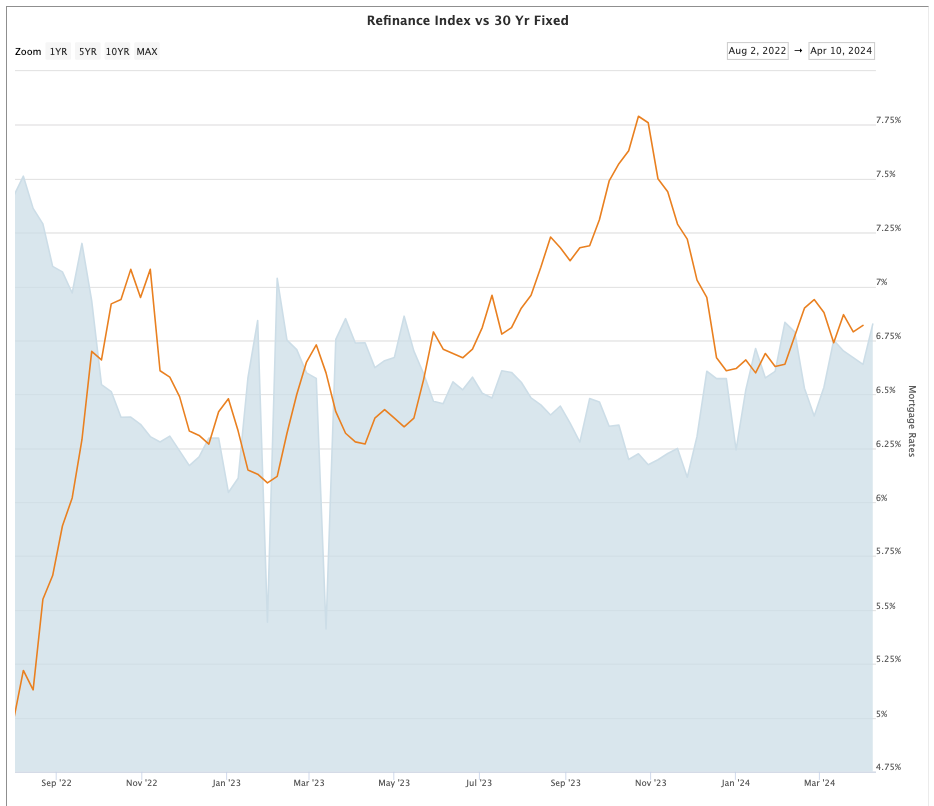Sales activity has also picked up, with 3,041 homes sold in September 2025, an increase of 4.97% from the 2,897 homes sold in September 2024. This data indicates a healthy demand for homes in the region. For a detailed visual representation of these trends, refer to the chart below, available exclusively from MORE, REALTORS®. This data-driven insight is essential for anyone interested in the St. Louis real estate market, whether buying, selling, or investing.
|
|||
|
The St. Louis Metropolitan Statistical Area (MSA) real estate market continues to show robust activity as of October 2025. Homes sold for a median price of $283,000 in September 2025, marking a 4.81% increase from the median price of $270,000 in September 2024. However, this represents a slight decrease of 0.70% compared to August 2025, when the median sold price was $285,000. The median list price in September 2025 was $285,000, a significant increase of 7.55% from $265,000 in the same month last year.
The real estate market in the St. Louis Metropolitan Statistical Area (MSA) experienced notable changes in August 2025. Homes sold for a median price of $285,000, marking a 5.24% increase from the median price of $270,800 in August 2024. However, this represents a slight decrease of 2.56% from July 2025, when the median price was $292,500. The median list price saw a similar trend, rising to $284,900 in August 2025, up 5.52% from $270,000 in August 2024.
In terms of sales volume, there were 3,306 home sales in the St. Louis MSA during August 2025, a slight decrease of 1.52% compared to the 3,357 homes sold in August 2024. For a visual representation of these trends, refer to the chart below, which is available exclusively from MORE, REALTORS®. This data provides valuable insights for buyers and sellers navigating the dynamic St. Louis real estate market. The St. Louis Metropolitan Statistical Area (MSA) real estate market demonstrated sustained growth in July 2025, with notable increases in both home sales and prices. Homes sold for a median price of $295,000, marking a 5.36% rise from the previous year’s median of $280,000, and a 1.72% increase from June 2025’s median of $290,000. This consistent upward trend underscores a robust housing market in the region.
In terms of sales volume, the market remained stable with 3,484 homes sold in July 2025, slightly up by 0.09% compared to 3,481 sales in July 2024. The median list price also saw a year-over-year increase, climbing 5.45% to $290,000 from $275,000 in July 2024. For a detailed visual representation of these trends, refer to the chart below, exclusively available from MORE, REALTORS®. This chart provides a clear overview of the market dynamics over the past year, illustrating the steady rise in home values and sales activity in the St. Louis MSA. Whether you are considering buying, selling, or simply keeping an eye on the market, these insights are invaluable for understanding the current real estate landscape in St. Louis. The St. Louis Metropolitan Statistical Area (MSA) real estate market experienced subtle shifts in June 2025. Homes sold for a median price of $290,001, showing a slight decrease of 2.68% compared to June 2024 when the median price was $298,000. This trend continued from May 2025, where there was a modest decline of 0.69% from a median sold price of $292,015. The median list price also saw a minor reduction to $289,500, down 0.14% from June 2024’s median of $289,900.
Despite the dip in prices, the volume of home sales in the region indicated a more positive note, with 3,299 homes sold in June 2025, marking a 3.00% increase from the 3,203 sales recorded in June 2024. For a detailed visual representation of these trends, refer to the chart below, available exclusively from MORE, REALTORS®. This chart provides a clear view of the pricing and sales volume trends in the St. Louis MSA real estate market, essential for both buyers and sellers looking to make informed decisions in this dynamic market. The St. Louis Metropolitan Statistical Area (STL MSA) real estate market demonstrated robust growth in May 2025, with median home sale prices reaching $292,500, marking an 8.33% increase from May 2024. This growth is also evident when compared to the previous month, April 2025, where the median sale price was $275,000, showing a 6.36% monthly increase. The median list price also saw a substantial rise to $289,450, up 9.23% from the previous year.
Despite the increase in prices, the number of home sales experienced a decline, with 2,968 homes sold in May 2025, down 13.57% from 3,434 sales in May 2024. This data, illustrated in the chart below, highlights significant trends in the STL MSA real estate market. The chart is available exclusively from MORE, REALTORS®, providing detailed insights into the ongoing changes in the local real estate landscape. For more detailed analysis and expert guidance, visit MORE, REALTORS®, specializing in St. Louis real estate. Buried in a 1961 Sunday Post-Dispatch Newspaper, an ad by Income Investment Co. promised St. Louisans a new home for a price “everyone” could afford—$9,650 with just $350 down and a principal-and-interest payment of $54.31. The 3-bedroom ranches in Eureka’s brand-new “Shaw’s Garden” subdivision even came with five king-size closets and concrete streets. Chrysler’s Fenton plant was ramping up a few miles away, and the ad all but wrote the script for the blue-collar American Dream. Fast-forward to 2025. That $9,650 price tag converts to roughly $99,000 in today’s dollars using the CPI, yet recent sales on the same streets: Hill, Weber and Butler, are closing around $225,000. In other words, every original dollar turned into about $2.25 of real value, beating inflation by more than double. But the monthly payment story paints an even clearer picture. In 1961, that $54 house payment represented about one-ninth of a typical household’s income. Today, even with Eureka’s median income above six figures, a similar slab ranch pushes that burden to around one-sixth. That’s a 26% increase in how much of the paycheck goes to just principal and interest. And it’s not just about mortgage interest rates. Even if mortgage rates dropped a full percentage point tomorrow, payments on a $225,000 home would still eat up about 14% of median income, well above the 11% level from 1961. The core issue is simple: home prices grew about 23 times since then, while incomes only rose about 19 times. In St. Louis, that’s playing out visibly in neighborhoods like Eureka, where a ranch listed at or below $250k might look like a bargain. But once you run the math, those “starter” homes are putting more pressure on buyers than they did 60 years ago. Taxes, insurance and HOA fees only stack the load higher. So how did a modest 1,200 square-foot ranch on a 60×125 lot beat the broader economy? It wasn’t upgrades or architecture…it was land, location, and scarcity. Back then it was Chrysler; today it’s Amazon’s hub, I-44 logistics, and a top school district. Even with remote work more common, homes near job corridors still carry value, just not as heavily as they once did. And this isn’t just true in Eureka: throughout the St. Louis metro area, plenty of communities still attract first-time buyers and value-focused shoppers looking for affordable homes in convenient locations with decent schools—places like Affton, Maplewood, Fenton, Maryland Heights, University City, St. Ann, St. Charles, and Pacific, to name a few. Key takeaways for 2025:
Thinking of selling a home you’ve owned forever? Or trying to make sense of today’s prices as a buyer or investor? Let’s run the numbers. Reach out to MORE, REALTORS® today and put some data behind your next move. 1961 Vintage Ad for New Homes in Eureka
When you think of booming home prices, places like Ladue (63124) or Clayton (63105) probably come to mind. But looking at home price appreciation in the St. Louis area from 2000 to 2024 tells a different story… and it might surprise you. At the top of the list? Benton Park and St. Louis Hills. Yes, you read that right, 63118 and 63109 outpaced every other zip code on the list, including the ones most associated with wealth. Homes in 63118 jumped a staggering 554% since 2000, while 63109 rose 184%. Meanwhile, Ladue came in at just 109% growth and Clayton even lower at 77%. For reference, the median home price in 63124 rose from $551,000 to $1.15 million, while Benton Park soared from $35,950 to $235,000. Sure, Ladue homes are still worth far more, but percentage-wise, the growth in some of the city’s more modest neighborhoods has been off the charts. So what’s driving this? It’s all about starting points and shifts. Many of these top-performing zip codes had very low home values two decades ago. As urban areas like Benton Park saw revitalization, investor interest, and a wave of younger buyers wanting walkability and charm, home values responded accordingly. Add in a limited supply and rising demand, and you’ve got a recipe for skyrocketing percentages. On the flip side, high-end areas like Ladue and Clayton already had elevated home prices in 2000. A million-dollar home today might have been $500k back then, but that’s still just a doubling in price. Wealthier neighborhoods simply didn’t have the same room for percentage growth, even though home values there are still some of the highest in the region. It’s also worth noting that all the zip codes in the table below were chosen based on affordability — or lack of it. These are the 10 zip codes in the St. Louis area where home prices are the least affordable relative to household income. So whether the neighborhood is a luxury enclave or a gentrifying part of the city, affordability is tight across the board. If you’re wondering what this means for your home value or where your next investment should be, this list might offer some new inspiration. Sometimes the “sleepers” turn out to be the best long-term bets. MORE, REALTORS® has access to the most up-to-date data and local expertise to help you make smart decisions in this ever-shifting market. The St. Louis Metropolitan Statistical Area (MSA) real estate market demonstrated notable growth in property values in March 2025. Homes sold for a median price of $265,500, marking a significant 6.20% increase from the previous year’s median of $250,000. This price point also reflects a consistent rise from February 2025, which saw the median sold price at the same level, indicating a stable upward trend in housing prices.
While home prices surged, the total number of home sales exhibited a slight decline. In March 2025, there were 2,347 homes sold, down 7.27% from the 2,531 transactions recorded in March 2024. The median list price for homes also escalated to $265,000, up 8.16% from $245,000 in the same month the previous year, suggesting a strong seller’s market. For a detailed visual representation of these trends, refer to the chart below, which is available exclusively from MORE, REALTORS®. This chart provides an in-depth look at the changes in the St. Louis MSA real estate market, helping buyers and sellers make informed decisions. Stay updated with the latest market trends by visiting our website or contacting a MORE, REALTORS® professional. A new national survey of experienced real estate agents sheds light on what’s really happening in the market—and what it means for St. Louis buyers, sellers, and investors. According to the data, affordability remains the single biggest concern agents face when looking ahead. Nearly two-thirds (64.2%) say it’s the top challenge over the next five years. With elevated interest rates and prices still outpacing income growth, the path to homeownership is tougher than ever for many buyers. But it’s not just affordability. Inventory shortages remain a pain point, with 42.8% of agents citing low housing supply as a major issue. This lines up with what we’ve seen in the St. Louis metro area—fewer listings, faster sales, and buyers still competing over move-in ready homes. At the same time, about half of agents surveyed believe that both home sales and prices will rise in 2025. That optimism, while cautious, shows confidence that demand is still there—and that conditions may improve slightly as rates stabilize and more sellers re-enter the market. Investors and current homeowners should also take note of a few emerging trends. Agents report a steady increase in insurance-related issues during transactions, particularly in high-risk states, and there’s a growing belief (39%) that climate change is influencing where buyers choose to live. While Missouri isn’t on the front lines of hurricanes or wildfires, shifting weather patterns and rising insurance costs could start playing a bigger role locally. Bottom line: Buyers and investors would do well to look beyond the price tag—digging into carrying costs, long-term risk factors, and neighborhood stability is more important than ever. The findings are based on a national survey of agents conducted by Redfin between December 2024 and January 2025. As of February 2025, the St. Louis real estate market continues to show strong growth. According to data from MORE, REALTORS®, the median sold price for homes in the stl msa update was $250,000, a 5.71% increase from the same time last year when the median sold price was $236,500. However, this month’s median sold price also represents a slight decrease of 2.53% from January 2025, when the median sold price was $256,500.
The median list price for homes in the stl msa update was also on the rise, with a 4.21% increase from February 2024, reaching $250,000. This indicates a strong demand for homes in the St. Louis area. Despite the increase in prices, there were 1821 home sales in the stl msa update in February 2025, a decrease of 11.94% from the same time last year when there were 2068 home sales. This could be due to a limited inventory of available homes. For a visual representation of the data, please refer to the chart below, available exclusively from MORE, REALTORS®. With the St. Louis real estate market showing continued growth, now may be a great time to buy or sell a home in the area. Contact a MORE, REALTORS® agent today for expert guidance and assistance with all your real estate needs. The real estate market in the St. Louis Metropolitan Statistical Area (MSA) continued to show strong growth in January 2025, according to the latest data from MORE, REALTORS®. Homes in the stl msa update sold for a median price of $256000, representing an 11.33% increase from January 2024 when the median sold price was $229950. This also marks a 0.39% increase from December 2024, when the median sold price was $255000.
The median list price for homes in the stl msa update was $250000, a 9.17% increase from January 2024’s median list price of $229000. Despite the increase in prices, there were 1753 home sales in the stl msa update in January 2025, a slight decrease of 3.68% from January 2024’s 1820 home sales. According to the chart below, available exclusively from MORE, REALTORS®, the stl msa update has consistently shown positive growth in both median sold and list prices over the past year. This trend is expected to continue as the real estate market in St. Louis remains strong. For all your real estate needs in the stl msa update, trust the experts at MORE, REALTORS®. When it comes to understanding home prices, many consumers focus on the dollar amounts they see in headlines. However, these numbers don’t always tell the whole story. A fascinating perspective emerges when we compare home prices not just in U.S. dollars but in terms of gold, a historical store of value. The chart below reveals that when measured in gold, home prices have remained relatively stable since the late 1980s, with the exception of the housing bubble and its subsequent crash.
While the dollar-based chart shows an upward trajectory in home prices, surging over 250% since the year 2000, the same homes measured in gold reveal a different reality. Adjusted for gold, home prices today are about the same as they were in the late 1980s. This perspective highlights the impact of the dollar’s declining purchasing power over time rather than true appreciation in home values. The illusion of soaring prices is largely driven by the devaluation of the dollar, not necessarily by real growth in housing value. For St. Louis home buyers and sellers, this means today’s high prices may not signify as much “appreciation” as they think. Sellers might consider this context when setting their expectations for value, while buyers should keep in mind that what they’re paying reflects broader monetary policies, not just local market conditions. The real estate market remains an excellent way to build wealth, but understanding its relationship with currency values provides a deeper insight into long-term investments. The chart below illustrates this concept perfectly, with the green line representing home prices in dollars and the blue line reflecting prices in gold. Whether you’re buying or selling, this perspective is a reminder to look beyond the surface and consider what drives the numbers. At MORE, REALTORS®, we’re committed to helping buyers and sellers navigate the real estate market with a clear understanding of market trends. Our team provides tools and insights to help you make confident decisions. Whether you’re investing in your first home or selling a long-held property, we’re here to assist. Case-Shiller Home Price Index Both In Dollars (Green) and Gold (Blue)
Recent data from the Federal Reserve Economic Data (FRED) charts below reveal interesting insights about St. Louis home prices in relation to the M2 money supply. Over the last several years, St. Louis home prices, represented by the red line, have steadily risen, reaching their current index value of 302.78 in Q3 2024. At the same time, the M2 money supply, shown by the blue line, has seen a more dramatic fluctuation, particularly during and after the pandemic, with a current value of over $21 trillion.
Historically, as the M2 money supply increases, home prices tend to rise as well, influenced by factors like inflation and the availability of credit. However, the recent stabilization of the money supply suggests that home price appreciation could slow down in the near future. For buyers, this might present an opportunity to find more balanced pricing. For sellers, especially those considering listing their homes soon, now may be a good time to take advantage of historically high prices before any potential cooling. At MORE, REALTORS®, our team is here to guide buyers and sellers through these changing market dynamics with expertise and personalized strategies. The real estate market in the St. Louis Metropolitan Statistical Area (MSA) saw continued growth in December 2024, with a median sold price of $260,000. This represents a 9.24% increase from December 2023, when the median sold price was $238,000. However, there was a slight decrease of 1.89% from November 2024, when the median sold price was $265,000. These figures are based on data exclusively available from MORE, REALTORS®.
The median list price in December 2024 also saw an increase of 8.33%, rising from $240,000 in December 2023 to $260,000. This indicates strong demand for homes in the St. Louis MSA. Despite the increase in prices, there were 2147 home sales in December 2024, a 9.29% decrease from December 2023. This could be attributed to the holiday season, as well as the ongoing supply shortage in the market. Overall, the St. Louis MSA real estate market continues to be a seller’s market, with rising prices and strong demand. If you’re looking to buy or sell a home in the area, contact MORE, REALTORS® for expert guidance and assistance. The St. Louis real estate market continues to show strong growth as we head into the end of 2024. According to the latest data from MORE, REALTORS®, the median sold price for homes in the stl msa update was $265,000 in November 2024. This represents a significant increase of 11.60% from November 2023, when the median sold price was $237,450.
However, there was a slight decrease in median sold price from the previous month, with October 2024 showing a median sold price of $277,000. This decrease of 4.33% is likely due to seasonal fluctuations and is not indicative of a larger trend. The median list price for homes in the stl msa update also saw a significant increase, rising to $265,000 in November 2024. This is a 12.77% increase from November 2023, when the median list price was $235,000. Despite these increases in prices, there were 2397 home sales in the stl msa update in November 2024, a slight decrease of 7.81% from November 2023. This could potentially be attributed to the ongoing supply shortage in the market. For a visual representation of these numbers, please refer to the chart below, which is available exclusively from MORE, REALTORS®. As always, our team is dedicated to providing accurate and timely data to help you make informed decisions in the St. Louis real estate market. For St. Louis homeowners considering selling their homes, the 2024 National Association of Realtors Profile of Home Buyers and Sellers offers valuable insights into current trends. According to the report, the median time a home spends on the market remains a swift three weeks, with 49% of all homes selling within just two weeks. For sellers, this indicates that pricing your home competitively and working with an experienced agent can lead to quick and successful sales. Additionally, the median sales price continues to align with the listing price, holding steady at 100% of the asking price. This consistency underscores the importance of proper market preparation and strategy. Homes that linger longer on the market often see price adjustments, as highlighted by the data showing 65% of sellers did not reduce their asking price, while 21% made one adjustment. Finally, homeowners’ motivations for selling reflect the changing dynamics of life. Whether it’s downsizing because a home feels too large (11%), relocating to be closer to family (23%), or moving due to a job relocation (7%), understanding these reasons can help sellers frame their decisions and goals effectively. If you’re considering listing your St. Louis home, connect with the local experts at MORE, REALTORS® to ensure you’re informed and prepared for a seamless selling experience. The full 2024 NAR report is available below for further insights. The real estate market in the stl msa update continues to show strong growth as we head into the fall season. According to the latest data from MORE, REALTORS®, the median sold price for homes in the stl msa update was $270,000 in September 2024, a 4.85% increase from the same time last year when the median sold price was $257,500.
While there was a slight decrease of 1.82% in median sold price from August 2024, when it was $275,000, this is still a positive sign for the market. The median list price also saw an increase of 7.60% from September 2023, jumping from $250,000 to $269,000. In terms of sales, there were 2629 home sales in the stl msa update in September 2024, a 5.70% decrease from the previous year. However, this is not uncommon as the market typically slows down in the fall season. The chart below, available exclusively from MORE, REALTORS®, illustrates the data mentioned above. As always, our team of experienced and knowledgeable real estate agents are here to help you navigate the stl msa update market and find your dream home. Contact us today for all your real estate needs. The St. Louis real estate market saw a slight increase in median home prices during August 2024, with homes selling for a median price of $275,000. This is a 3.77% increase from August 2023, when the median sold price was $265,000. However, compared to July 2024, there was a decrease of 3.51% in median sold price, when it was $285,000.
According to the chart below, provided exclusively by MORE, REALTORS®, the median list price for homes in the St. Louis MSA also saw an increase of 7.84% from August 2023, with a current median list price of $275,000. However, there were 2973 home sales in August 2024, a 10.72% decrease from August 2023. This data suggests that the St. Louis real estate market is still experiencing steady growth, but at a slower pace compared to previous years. As we head into the fall season, it will be interesting to see how the market continues to evolve. If you’re looking to buy or sell a home in the St. Louis area, contact MORE, REALTORS® for expert guidance and assistance. Our team of experienced agents are dedicated to helping you achieve your real estate goals. The St. Louis real estate market continues to show strong growth, with the median sold price for homes in the stl msa update reaching $288,500 in July 2024. This represents a 6.89% increase from the same time last year when the median sold price was $269,900. However, there was a slight decrease of 3.80% from June 2024, when the median sold price was $299,900.
The median list price for homes in the stl msa update also saw an increase, reaching $280,000 in July 2024, up 5.70% from July 2023. This indicates that sellers are able to command higher prices for their homes in this market. According to the chart below, provided exclusively by MORE, REALTORS®, there were 2,944 home sales in the stl msa update in July 2024, a slight increase of 0.48% from the same time last year. This data shows that the St. Louis real estate market remains active and competitive. As we continue to see growth in the St. Louis real estate market, it is a great time for both buyers and sellers to make their move. Whether you are looking to buy or sell a home in the St. Louis area, the experienced agents at MORE, REALTORS® are here to help you navigate this dynamic market. Contact us today to get started on your real estate journey. As of June 2024, the stl msa real estate market continues to show strong growth. According to data exclusively from MORE, REALTORS®, the median sold price for homes in the stl msa update was $299950, a 9.07% increase from June 2023. This also marks a 9.07% increase from May 2024, when the median sold price was $275000.
The median list price for homes in the stl msa update was $290000, a 9.43% increase from June 2023. Despite the increase in prices, there were 2800 home sales in June 2024, a decrease of 18.60% from June 2023. The chart below illustrates the data and is available exclusively from MORE, REALTORS®. This update shows that the stl msa real estate market remains competitive and continues to be a strong investment for buyers and sellers alike. Stay tuned for more updates on the stl msa real estate market from MORE, REALTORS®. A recent article in the St. Louis Business Journal highlights the prominence of St. Louis in the newly released Business Journals Wealthy 1000 ranking. Among the nation’s wealthiest ZIP codes, nine from the St. Louis area have made the list, underscoring the region’s economic significance. Leading the charge is Ladue’s 63124 ZIP code, recognized not only as the wealthiest in St. Louis but also a major player on the national stage. This new ranking takes into account various wealth metrics such as income, home equity, and estimated savings, painting a comprehensive picture of affluence in the area. While Ladue tops the local list with an impressive average home price of $2,239,362, other affluent St. Louis County ZIP codes, including Clayton’s 63105 with an average home price of $1,727,632 and Town and Country’s 63131 with an average home price of $1,600,141, also feature prominently. The diversity of these areas, from the suburban charm of Chesterfield to the upscale vibe of Clayton, showcases the broad spectrum of luxury living within St. Louis County. In conjunction with this prestigious national recognition, we at MORE, REALTORS® have our exclusive list of the average home prices in the top St. Louis ZIP codes below. This list provides a snapshot of the real estate landscape, highlighting the premium property values that align with the wealth rankings. Whether you’re looking to buy or sell in these coveted areas, our data offers valuable insights into the current market dynamics. The latest data from MORE, REALTORS® reveals that the St. Louis Metropolitan Statistical Area (stl msa) real estate market is showing no signs of slowing down. In May 2024, the median sold price for homes in the stl msa reached $275,000, a 7.84% increase from the same month in 2023 when the median sold price was $255,000.
Compared to the previous month, May 2024’s median sold price of $275,000 also saw a 5.81% increase from April 2024’s median sold price of $259,900. This steady growth in home prices is a positive sign for sellers in the stl msa. Additionally, the median list price for homes in the stl msa was $269,900 in May 2024, an 8.18% increase from the median list price of $249,500 in May 2023. This indicates that sellers are able to list their homes for higher prices, and buyers are willing to pay. The stl msa also saw an increase in home sales, with 3049 homes sold in May 2024, a 4.35% increase from May 2023’s 2922 home sales. This further demonstrates the strong demand for homes in the stl msa. As the chart below, available exclusively from MORE, REALTORS®, shows, the stl msa real estate market continues to be a hot market for both buyers and sellers. With rising home prices and steady sales, now is a great time to buy or sell a home in the stl msa. Contact a MORE, REALTORS® agent today for expert guidance and assistance in navigating the stl msa real estate market. As of April 2024, the St. Louis metro area real estate market continues to show steady growth. According to data from MORE, REALTORS®, the median sold price for homes in the St. Louis area was $260,000, representing a 2.36% increase from April 2023 when the median sold price was $254,000. This also marks a 4.00% increase from the previous month, March 2024, when the median sold price was $250,000.
The median list price for homes in St. Louis was $250,000, a slight 0.04% increase from April 2023. This indicates that sellers are still able to command a strong price for their homes in the current market. In terms of sales, there were 2,634 home sales in the St. Louis metro area in April 2024, a 9.70% increase from April 2023. This shows a continued high demand for homes in the area. For those looking to buy or sell a home in the St. Louis metro area, now is a great time to take advantage of the strong market conditions. With the help of a knowledgeable and experienced REALTOR from MORE, REALTORS®, buyers and sellers can navigate this competitive market with confidence. Stay tuned for more updates on the St. Louis real estate market. The St. Louis Metropolitan real estate market has experienced notable shifts in its latest 12-month cycle ending April 2024, as compared to the previous year. Firstly, the total number of homes sold in the St. Louis Metro area has seen a decline. Over the past 12 months, ending April 2024, St Louis home sales totaled 32,220 homes, a decrease of 6.58% from the previous year’s 34,490 homes. This reduction in sales volume may reflect a variety of market factors including economic shifts or changes in buyer sentiment.
Conversely, the median sold price for homes has edged upwards, indicating a resilient market valuation. The median sold price for homes in St Louis rose by 1.92% from $249,900 in the prior year to $254,700 in the period ending April 2024. This growth suggests a sustained buyer interest in value, despite the lower sales volume. Inventory dynamics also present an intriguing picture. The number of listings sold last month was 2,612, with current listings standing at 2,840, and a supply of just over one month (1.09 months). These figures, coupled with a median of 22 days on market, highlight a competitive and swift market environment, challenging both buyers and sellers to act efficiently. The STL Market Report below, available exclusively from MORE, REALTORS®, has more details on the above information as well as additional useful St Louis market data as well. For prospective buyers, sellers, and investors, understanding these market dynamics is crucial. The expertise of MORE, REALTORS® can provide the necessary guidance and strategic advice to effectively navigate this evolving market landscape. Since the National Association of Realtors (NAR) and the plaintiffs in the following lawsuits—Christopher Moehrl v. The National Association of Realtors et al., Rhonda Burnett (originally Sitzer) v. The National Association of Realtors et al., Dawin Niel Umpa v. The National Association of Realtors, et al., and Don Gibson v. The National Association of Realtors—reached a settlement agreement on March 15, 2024, which is still pending court approval and thus preliminary at this point, the topic has dominated industry conversations. The focus of these lawsuits on buyer’s agent commissions has attracted more media attention since mid-March than it seems to have received in the over 40 years I’ve been in the business before that. Don’t get me wrong, I’m not saying all this attention is bad. In fact, I believe it is beneficial. I’ve long advocated for educating consumers, feeling that the more home buyers and sellers know, the better decisions they can make. This is why I’m rapidly approaching the milestone of 3,000 articles on the topic of real estate in St. Louis on this site. Now, I don’t do this solely for altruistic reasons; sharing the information and knowledge I’ve gained either through experience or research is also self-serving. As a broker-owner of MORE, REALTORS®, I’ve put forth just as much effort in sharing knowledge with our agents, and I am blessed to be surrounded by real estate professionals who are as eager as I am to increase their knowledge and hone their skills to better serve clients. Here’s the reward for me: informed and knowledgeable consumers seek out better and more professional agents, like the ones we’re in business with, creating a win-win situation. As of 2023, according to data from the Missouri Department of Elementary and Secondary Education and the Illinois State Board of Education, there are roughly 135-145 school districts within the 17 counties of the St. Louis Metropolitan Statistical Area (MSA). This figure includes public school districts but excludes private and charter schools. These districts vary significantly in size, home prices, and demand for homes. While strong school districts and top-rated schools are major attractions for home buyers and may reflect in the prices homes fetch compared to those in lesser districts, they do not guarantee quick sales. However, it is logical to assume that the quality of schools can significantly influence demand in various subdivisions.
What are the fastest-selling school districts in the St. Louis metro area currently? As of today, the list below, available exclusively from MORE, REALTORS®, indicates that the Windsor C-1 School District in Jefferson County is the fastest-selling, with homes staying on the market for an average of just 5 days. It is followed by Smithton DIST 130 in Illinois, with an average of 6 days on the market, and Sunrise R-IX in Jefferson County, taking third place with 7 days. St. Clair County in Illinois claims five of the top ten spots for the fastest-selling school districts, followed by Jefferson County with three. It should be noted that smaller school districts, with fewer homes on the market, may have an advantage over larger districts with more extensive inventory. The real estate market in St. Louis is notably diverse, featuring homes that are, on average, quite affordable. However, this affordability doesn’t preclude the existence of luxury markets within the city. Presented below is an exclusive list from MORE, REALTORS® detailing the top 10 cities in the St. Louis MSA where homes command the highest average selling prices.
Key takeaways from this list include:
Additional cities such as Westwood, Josephville, Town and Country, and Clarkson Valley also feature on the list, each contributing unique market traits but collectively underscoring the strong demand for high-end residential properties in the area. Last week, the interest rates for 30-year fixed-rate mortgages climbed past the 7 percent mark. Despite this increase, as the chart below illustrates, there was a significant 10 percent increase in refinancing applications. This is in sharp contrast to a 5 percent decline in purchase applications. The growth in the refinancing segment is notable, representing 33.3 percent of the total application volume, up from 30.3 percent the previous week. This surge in refinancing interest is particularly intriguing, given the highest reported 30-year mortgage rates in over a month, at 7.01 percent.
Joel Kan, MBA’s Vice President and Deputy Chief Economist, attributed the rising rates to the Federal Reserve’s cautious stance on adjusting policy amidst persistent inflation and resilient economic indicators, including strong employment data. Despite the unfavorable rate environment, the demand for refinancing, especially VA refinancing, remained robust. Other notable trends include a decrease in average loan sizes, with purchase loan sizes—often viewed as a proxy for home prices—dropping to $449,400 from $453,000. Additionally, there was a shift in the composition of mortgage applications, with increases in FHA and VA loan shares. So, what explains the rising number of homeowners refinancing their mortgages even with rising mortgage interest rates? There are numerous reports indicating that many homeowners across the country are becoming cash-strapped and having a difficult time paying bills, thus resorting to pulling out equity from their homes, even if it means accepting a higher interest rate. I’ve also observed reports indicating that consumer credit card debt is at historically high levels, with interest rates on this debt being astronomical. This situation is prompting people to refinance their home loans again, even at higher rates, because even though their mortgage may be at a higher rate, it still appears to be a bargain compared to the 27 or 28% on a credit card. I haven’t seen enough verifiable data to confirm if either of these situations is true, but both are plausible. The ebb and flow of St. Louis’s real estate market are linked to the broader economic currents, and recent weeks have witnessed a significant uptick in mortgage interest rates. In the video below, Traci Everman, Senior Mortgage Banker with Flat Branch Home Loans, does a fantastic job of explaining what is happening and why. Below the video are some highlights and a recap. Here are are few highlights of what Traci’s covers in the video: Recent Economic Impacts on Mortgage Rates:
Analyzing PCE Inflation and Jobs Reports:
Current State of Mortgage-Backed Securities:
How Recent Trends May Affect Future Rates:
Conclusion: Staying Informed on Market Changes: For a more detailed dive into what this means for your home buying or selling decisions, stay connected with St. Louis Real Estate News. Stay informed. The St. Louis MSA residential real estate market is experiencing a phase of transformation. While the sales volume has seen a downturn, median sale prices have held steady, indicating a resilient market underpinned by solid demand. The complete STL Market Reports for the entire metro area as a whole, as well as the major counties, are available exclusively from MORE, REALTORS® and are below. Key Findings:
County Highlights:
Market Implications: The St. Louis MSA real estate market is currently defined by a decrease in the number of homes sold but a general uptrend in prices. The PPSF analysis reveals a market correction, yet the trend suggests prices might increase shortly.
The real estate landscape in the St. Louis metro requires careful navigation, with sellers possibly leveraging the low supply and buyers staying cautious of the potential for increasing prices. Stay informed with St. Louis Real Estate News for ongoing analysis and insights into local market trends. Continue reading “St. Louis Area Residential Real Estate Market Report For March 2024“ |
|||
|
St Louis Real Estate Search® St Louis Home Values St. Louis Real Estate News Contact Us Copyright © 2025 Missouri Online Real Estate, Inc. - All Rights Reserved St Louis Real Estate News is a Trademark of Missouri Online Real Estate, Inc. Missouri Online Real Estate, Inc. 3636 South Geyer Road - Suite 100, St Louis, MO 63127 314-414-6000 - Licensed Real Estate Broker in Missouri The owner and authors this site are providing the information on this web site for general informational purposes only and make no representations, warranties (expressed or implied) or guarantees of any kind whatsoever, as to the accuracy or completeness of any information on this site or of any information found by following any link on this site. Furthermore, the owner and authors of this site will not be liable in any manner whatsoever for any errors or omissions in information on this site, nor for the availability of this information. Additionally the owner and authors of this site will not be liable for for any losses, injuries or damages in any way from the display or use of this information or as the result of following external links displayed on this site, or by responding to advertisements displayed, or contained, on this site
In using this site, users acknowledge and agree that the information on this site does not constitute the provision of legal advice, tax advice, accounting services, investment advice, or professional consulting of any kind nor should it be construed as such. The information provided herein should not be used as a substitute for consultation with professional tax, accounting, legal, or other competent advisers. Before making any decision or taking any action on this information, you should consult a qualified professional adviser to whom you have provided all of the facts applicable to your particular situation or question. None of the tax information on this web site is intended to be used nor can it be used by any taxpayer, for the purpose of avoiding penalties that may be imposed on the taxpayer. |
|||








